In traditional embroidery, people use numerous fabrics as they are more comfortable than leather and are softer and warmer. But fabric used in embroidery varies from a different thread, cotton, linen, and blends. The material you select will depend upon the clothing you are planning to make and the techniques you will use.

Best Embroidery Fabric
Trying to find out the best fabric that can be hard and maybe challenging to choose. If you are self-taught and a beginner choosing the best embroidery fabric can be rather tricky for you. Choosing the embroidery fabric depends upon the type of thread, cotton, linen, or blends you will be using. And what kind of technique will you use.
A good fabric is easy to stitch, but when worn, it provides comfort and comes with design. Furthermore, a fabric is something that protects your skin and keeps you fresh while you wear it.
Here is a buyer’s guide that will help you choose the best-suited fabric and explain what you need to know before buying fabric for embroidery.
Buyer’s Guide:
- Thread Count: The number of threads per square meter is the thread count of the fabric. It decides how easy it will be to stitch fabric. For instance, all the fabric reviewed below is easy to stitch as they have a thread count of less than 150.
- Natural Fabric: There is nothing in this world that can surpass natural creations. So when buying fabric, you should try to find the nature of it. For example, cotton, linen, silk, wool, or a blend of these are natural solid fabrics and comfortable when worn. It is easy to stitch such a kind of fabric, and they don’t pose a problem while you wear it.
- Pre-Wash: When you wash any fabric, it contracts. This is due to yarn soaking up the water and swelling up. This results in threads contract. So, it would help if you washed them before stitching to avoid inconvenience and deliver a perfect end-product.
- Stabilizing And Trying: While stitching, you should stabilize the fabric, this tightens the weave, and you can perfectly stitch as the way you want. And if you are unsure of the cloth and results of your stitching, you can always try it as it gives you a basic idea of what you lack.
Here are the types of fabric that are used in embroidery that are readily available. You can find them in any cloth store or other source:
1. Linen
Instead of cotton, linen is made up of fibers extracted from stems of the flax plant, making it the best choice for hot and humid weather. Linen offers up a classy look and gorgeous texture to your embroidery. It may be hard to stitch through linen, but you don’t have to worry about the threads showing in the back.
The range and types of quality that linen offers are too vast, so before you use linen, you have to ensure what type of stitching project you will use. Every situation needs a different solution. For instance, you are stitching is a counted cross-stitch piece, then you will need even-weave linen.
100% pure linen doesn’t stretch while stitching making it a perfect fabric for ideal clothing. It also absorbs moisture but has low heat-retention abilities. You can’t wear it in cold weather as it doesn’t trap heat inside.
Furthermore, linen doesn’t stretch while you are sewing. For beautiful embroidery, you can choose linen as it absorbs moisture due to the ability of flax. Moreover, linen is the best fabric embroidery you can use to know your thread counts and stitching project.

2. Cotton
Cotton is made up of the cotton plant’s surrounding fiber that grows in a boll, and it is the most popular fabric used in clothing. It is used in various life aspects starting from apparel, bath lines to bedsheets and medical supplies.
If you want to stick on a patterned fabric, you should use cotton as a fabric. Using 100% cotton, you can stick to various fabrics like clothes, towels, bedsheets. Cotton fabric is easy to clean and helps you breathe freely.
You don’t have to worry about weather conditions as the cotton fabric is easy to keep warm, soft, and close to the skin. Furthermore, hypoallergenic means that your skin won’t feel irritated and feel fresh while you wear it. 100% cotton fabric is free of human-made chemicals and is a purely natural fabric.
It is a stretchable, heat-resistant, moisture-wicking fabric that can help you spend your day in a new mood. For easy-to-wear and clean clothing with freshness and moisture-absorbance, you should use cotton fabric.

3. EvenWeave Fabric
Evenweave fabric is the evenly stitched fabric both horizontally and vertically. Furthermore, even weave fabric, when tightly woven, can be used as a surface embroidery and is the best in this case. This fabric has a relatively higher number of threads and commonly ranges from 25 to 32 counts.
They are generally cotton-rayon blends and are a great fabric to use if you learn to stitch over two. Moreover, it is the best-suited fabric for advanced patterns with fractional stitches, making you wear something dashing. Moreover, if you are looking to cross-stitch or count-stitching, then you should choose even weave fabric.
Many kinds of cotton and rayon blending ratio variables are available on the market, so choose the best-suited one. They are primarily used in needlework and cross-stitch, and other specific types of hardeners. Furthermore, they are widely used in mats and other clothing that is used in cleaning.
It is more refined in appearance than Aida and is best suited for counted stitching such as cross-stitching, needle-work, etc.
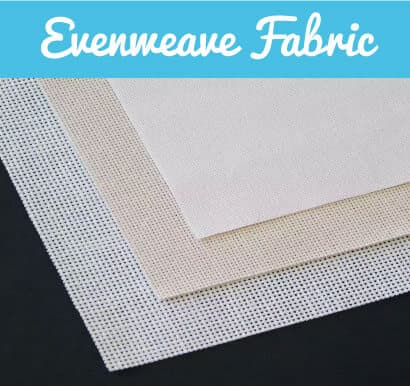
4. Aida Cloth
Due to the easy count square of stitched patterns, Aida cloth is widely used by beginners and novice stitchers. It is easy to sew and is widely used by people due to its variety and designs. Moreover, Aida cloth is the best choice of fabric for you if you are a novice and want to try something different.
But due to its large and opened weave, it is considered a lesser fabric than cotton and linen. The majority of people use this fabric as it is easy to stitch and is stylish in both quality and design.
It has a thread count of 7 to 28 and comes in different colors and styles. Furthermore, it tends to fray, so they need hemming before putting them to use. Washing it contracts the material, so it is required to wash it to close the spots that may be left open while stitching.
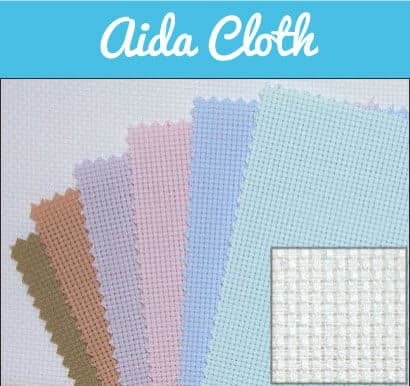
5. Hardanger Fabric
Hardanger is a type of embroidery, and there is a unique material used in this embroidery. Most commonly known as Hardanger fabric is 100% cotton fiber but with 22 count fiber. Sometimes called whitework, embroidery works with white thread or white linen fiber using counted and drawn thread techniques.
For a beautiful design on your clothing, you should use Hardanger fabric to be transparent to every color and display great artwork. Furthermore, with details in every intricate filling stitch, you make the best design according to the color and layout of the cloth.
Using the geometrical design, you use Hardanger fabric to design a cloth that amplifies its beauty. Moreover, It is the perfect fabric to sew or embroider the design on any cloth as it is white and intricate, filling details with depth.
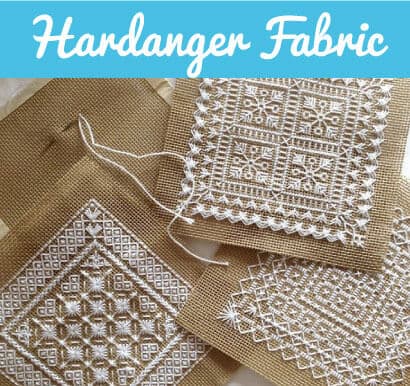
6. Toweling
Using stitching-technique or ready-mate fabric, you sew a piece of cloth that absorbs moisture and doesn’t become dirty and easily cleanable. Most commonly known to us as Towel. It is made up of Flour sack fabric stitched on and used to absorb water and liquid. Moreover, all the cotton is woven with loops to create highly absorbent embroidery cloth.
If you want a piece of cloth that will clean spilled water, oil, grease, paint, and any liquid from the surface, then you should use toweling fabric. Toweling fabric is the best choice for cleaning, drying, wiping the surface. Furthermore, cotton toweling fabric doesn’t lose its color and vibrancy, so it is best suited for cleaning services.
To clean up any liquid, you should stitch toweling fabric as it has a high absorbent ability and is made up of 100% cotton, meaning it won’t lose its colors and vibrancy after some use.
When the woven or knitted fabric is looped with a double side and is made up of cotton, it becomes highly absorbable. It is hemmed 4-5 times to make its best use for cleaning, and it doesn’t lose its vibrancy after use.
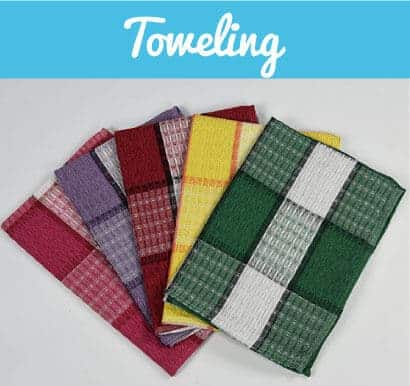
7. Wool
Wool is a type of fabric that doesn’t stretch and nor have any weave. It is a moderately breathable fabric, but it comes with both moisture-wicking and heat-retention abilities. Furthermore, it is commonly used in hats, sweaters, socks, suits, gloves, and other safety equipment as it is warm.
It is a fabric that is derived from an animal’s hair, such as sheep. Throughout decades wool and cotton have gone toe-to-toe as the most used fabrics. Wool may be hard to stitch, but it is widely used in cold weather as it is warm and provide comfort when you wear it.
Wool was widely used in cold areas as it tends to trap heat inside and absorb moisture. Furthermore, it is made up of animal hair, making it super durable and heat-resistant fabric.
Accessories like gloves, hats are made from hairs of animals that are spun into yarn. Most manufacturers use this technique to create wool, and it is commonly known for its durability and ability to insulate heat. Moreover, it is the best fabric to wear in cold weather as it is durable and thermally insulated.

8. Denim
The most popular and used fabric by men and women in denim jeans. Everyone understands what jeans are. Firstly, cotton is cultivated then processed into yarn, and in the end, yarn is dyed and given a shape of a material known as jean. Denim Fabric is durable and tends to provide stretchy and comfy wear.
The most popular end-products of denim fabric are jeans, skirts, shirts, vests. Furthermore, it is also used in belts, shoes, purses, and hats. However, all the popularity denim fabric may have, but it has one big drawback: the use of the chemical in it. Nylon, polyester are widely used in Denim fabric to add style to the wearer.
However, to overcome that, specific steps are taken to ensure that the denim fabric is safe to use and wear. It has become a symbol of modern clothing all around the world.
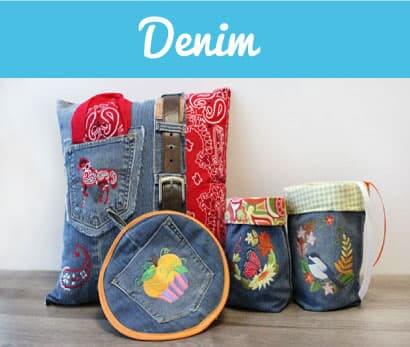
9. Silk
Silk is a fiber created from silkworm incest and is a highly breathable fabric. Furthermore, it has a thread count of up to 600 and can be hand and machine washed. It may have the high moisture-wicking ability but a low heat-trapping capacity.
It has a smooth texture and is widely used as nightgowns, robes, parachutes, etc. Moreover, silk is the most potent natural fiber in the world but is it rather expensive. Silk smoothness is the main reason that it gains popularity as clothing.
As if that’s not enough, silk fabric is vastly used for fresh and easy wear. With its softness, it has become the best clothing to chill in. It gives low stretchability and can be washed with both cold and warm water. So if you are looking for smooth texture and softness in the cloth, you should stitch using silk fabric.
